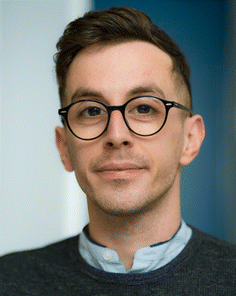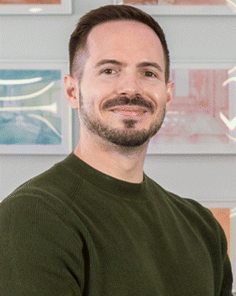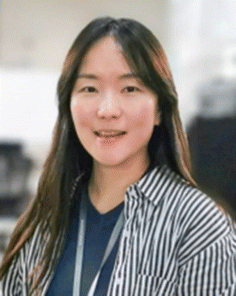Nanoscale Horizons Emerging Investigator Series: Dr Luciano Colazzo, Dr Christoph Wolf and Dr Yujeong Bae, IBS Center for Quantum Nanoscience, South Korea
Abstract
Our Emerging Investigator Series features exceptional work by early-career nanoscience and nanotechnology researchers. Read Luciano Colazzo, Christoph Wolf and Yujeong Bae's Emerging Investigator Series article ‘Template-directed 2D nanopatterning of S = 1/2 molecular spins’ (https://doi.org/10.1039/D2NH00375A) and read more about them in the interview below.
Dr Luciano Colazzo is a researcher at the IBS Center for Quantum Nanoscience, engaged in the field of nanotechnology chemistry and quantum technologies. He was awarded an independent research grant, the IBS Young Scientist Fellowship and, as of late 2021, he is the lead researcher for the “On-Surface Quantum Chemistry” project. His research focuses on the on-surface synthesis of molecular qubit arrays, by enforcing a multidisciplinary approach that encompasses quantum mechanics, molecular chemistry, and surface sciences.
Read Luciano Colazzo, Christoph Wolf and Yujeong Bae's Emerging Investigator Series article ‘Template-directed 2D nanopatterning of S = 1/2 molecular spins’ ( https://doi.org/10.1039/D2NH00375A ) and read more about them in the interview below:
NH: Your recent Nanoscale Horizons Communication reports the nanofabrication of a 2D patterned array of Vanadyl Phthalocyanine (VOPc) molecular spin qubits with controlled spin–spin distance, electronic decoupling from the supporting substrate, and individual addressability. How has your research evolved from your first article to this most recent article and where do you see your research going in future?
LC: There's a fundamental desire to unveil the interesting properties of the infinitesimally small world of atoms and molecules. Our latest article, indeed, brings in the efforts of a research team committed to the study of quantum phenomena at the nanoscale. The fundamental points of this publication represent each a necessary step towards the fabrication of a functional nanostructure: from addressing a single molecule to the fabrication of a 2D patterned array. Each of these key elements represent a fundamental ingredient and the final product is meant to move the field forwards toward the implementation of quantum nanostructures in the real world.
CW: The field of quantum coherent nanoscience is a relatively young one, with the foundation laid only about 5 years ago when our research center, the Center for Quantum Nanoscience, started operations. As such, our research is also rapidly evolving, with this article being only one of many that moves the field forward toward quantum-coherent nanostructures. I am anticipating that we will be able to demonstrate – in theory and experiment – the creation of entangled states in such engineered quantum systems within the near future!
YB: Over the past few decades, the field of quantum nanoscience has rapidly grown with the desire to harness quantum states for future technologies. As a part of these revolutionary works, our research focuses on the demonstration of quantum engineering at the atomic scale. Since the first demonstration of coherent manipulation of a single spin on a surface in 2019, where we have shown extremely high addressability, we have advanced our work to achieve scalability and robustness of quantum coherent properties. Our recent article published in Nanoscale Horizons shows one of the approaches to achieving scalability by leveraging the self-assembly properties of molecules, where the molecules carry spins with presumably long spin coherence time. To this extent, we are looking forward to demonstrating quantum logic operations using these artificially built spin structures on a surface.
NH: How do you feel about Nanoscale Horizons as a place to publish research on this topic?
LC: The journal is an excellent platform to share the relevant nanotechnology topics that our research is based upon, and I am happy I had the opportunity to publish here.
CW: Our work being truly “nanoscale”, with the functional units barely measuring a nm across, Nanoscale Horizons was a great match, and I am very happy that we were able to place our research in this journal.
YB: I think Nanoscale Horizons is the right place to publish our work as the journal's scope aligns well with our work, which is centred on a new approach to construct an ordered array of surface molecules at the nanoscale. I feel quite positive about this opportunity to publish our article in Nanoscale Horizons.
NH: What aspect of your work are you most excited about at the moment?
LC: The possibility to create tailored nanostructures with atomic precision and the good traction that this topic has in science and society. Quantum nanoscience and technology is still in its infancy but it's very exciting to think that one day we will use this kind of research for real world applications.
CW: Quantum nanoscience is a very young field. Currently, we are focusing on getting the message out, that quantum-coherent manipulation of individual atoms or molecules is indeed possible and that quantum-functional nanostructures can be built bottom-up or top-down. The positive reception of our work at conferences worldwide keeps me motivated!
YB: Our work bridges surface science and molecular magnetism. In molecules, spin coherence time can be enhanced by diluting them in space. However, these approaches are often limited to solution or powder forms, which limits the addressability of individual spin centres and the application to the device. In our work, by having a non-magnetic molecular layer as a template, the spin-carrying molecule could have been arranged in its intrinsic crystal form in a highly ordered phase. This work shows the transition of the ensemble studies on molecular qubits to addressable spin qubits in the solid state.
NH: In your opinion, what are the most important questions to be asked/answered in this field of research?
LC: The quantum world is a very strange place. On one hand the right questions to ask are those that finally help to unveil a new phenomenon or a special behaviour of a quantum object. On the other hand, and in my opinion, the most important ones are about how much control we truly have on this infinitesimally small reality.
CW: We want to know if Richard Feynman was correct when he postulated that quantum computers could be built directly from quantum matter – and I think we are getting closer to answering this question with a resounding YES!
YB: In my opinion, the most crucial question revolves around achieving a delicate balance between seemingly contradictory concepts, such as addressability versus scalability, and robustness versus controllability. Additionally, it's imperative to explore the transition from macroscopic or mesoscopic studies to microscopic or nanoscale investigations, as well as the shift from top-down approaches to bottom-up methodologies. These questions are all highly relevant to the realm of nanoscale studies and their potential implications for future technologies.
NH: What do you find most challenging about your research?
LC: As it is an interdisciplinary field, the most challenging aspect of my research is connecting and associating together the ideas and hypotheses stemming from different disciplines (mathematics, physics, chemistry). The ambition is to be able to create a “Rosetta Stone” or a common quantum dictionary, to facilitate the exchange of big ideas in a common language.
CW: Starting a new direction of research in an established field is not always an easy task. Winning over sceptics who have claimed for years that “this couldn’t possibly be done” can be challenging – but also rewarding.
YB: The most challenging aspect lies in finding a balance between mission-driven and curiosity-driven research. I believe that much of our research is mainly fuelled by curiosity. However, such work may not always have apparent practical applications, where most researchers will face difficulties when it becomes necessary to convey the excitement and relevance of our work to others.
NH: In which upcoming conferences or events may our readers meet you?
LC: Mainly conferences and workshops around South Korea.
CW: You will most likely find me at March meetings of the German Physical Society (DPG) or conferences and workshops throughout South Korea.
YB: This year, I plan to attend the International Conference on Quantum Nanoscience and the 2023 Fall Meeting of the Korean Physical Society in October, the WE-Heraeus-Seminar on Plenty of Room at the Bottom – New Developments in Scanning Probe Tools in November and the 13th International Conference on Advanced Materials and Devices in December.
NH: How do you spend your spare time?
LC: I love photography, digital art and gardening.
CW: Between research, running a research group and attending conferences I spend most of my spare time doing indoors and outdoors sports activities to stay fit!
YB: I enjoy meeting friends or family members and doing new activities to refresh myself.
NH: Can you share one piece of career-related advice or wisdom with other early career scientists?
LC: A piece of advice I’d like to give is to never stop being visionary. To plan the future with wisdom and imagination and to create a network of like-minded individuals around you.
CW: Research is hard, and good research is often harder. Stay persistent and build a reliable network of collaborators. Together we can achieve much more than each of us alone!
YB: Things might not go as we plan, which makes our work challenging and exciting.
| This journal is © The Royal Society of Chemistry 2023 |



